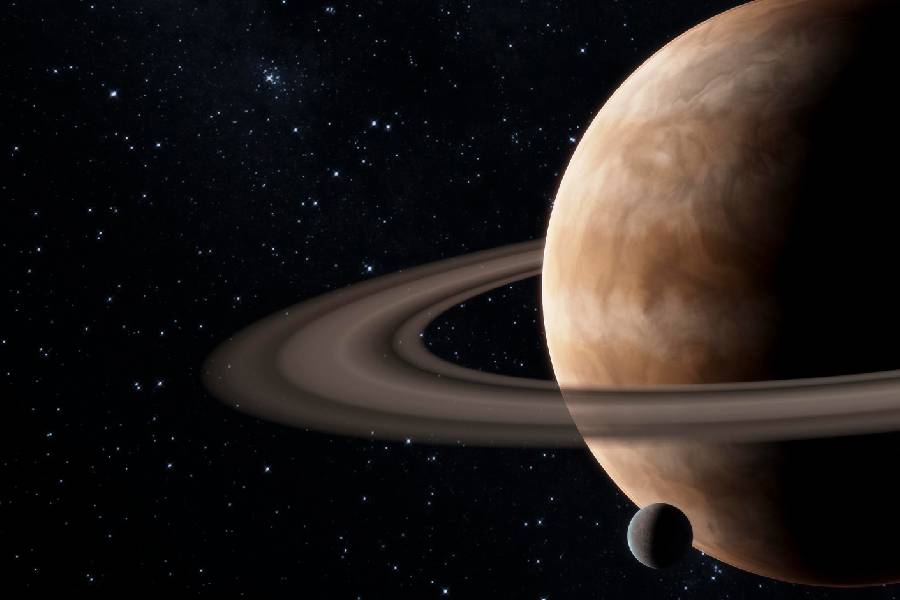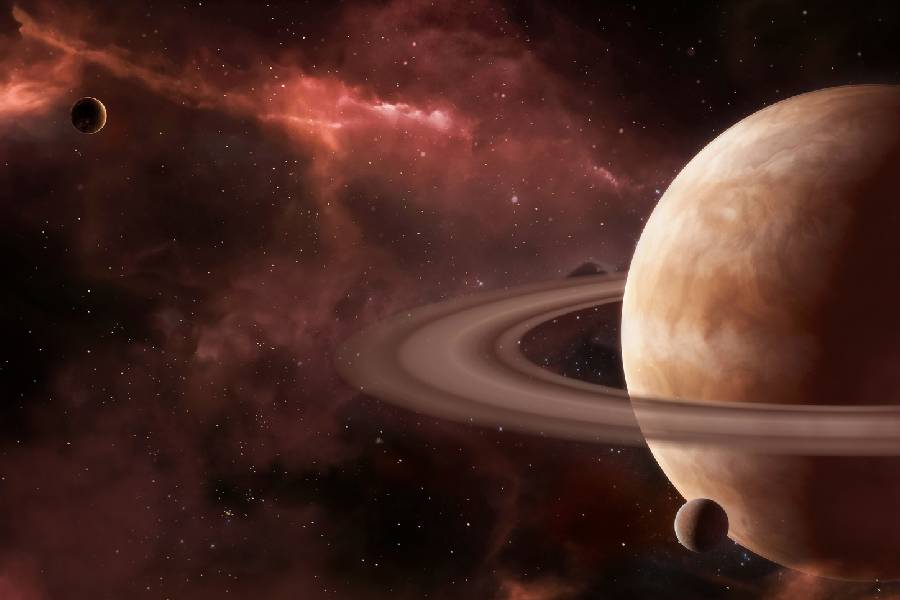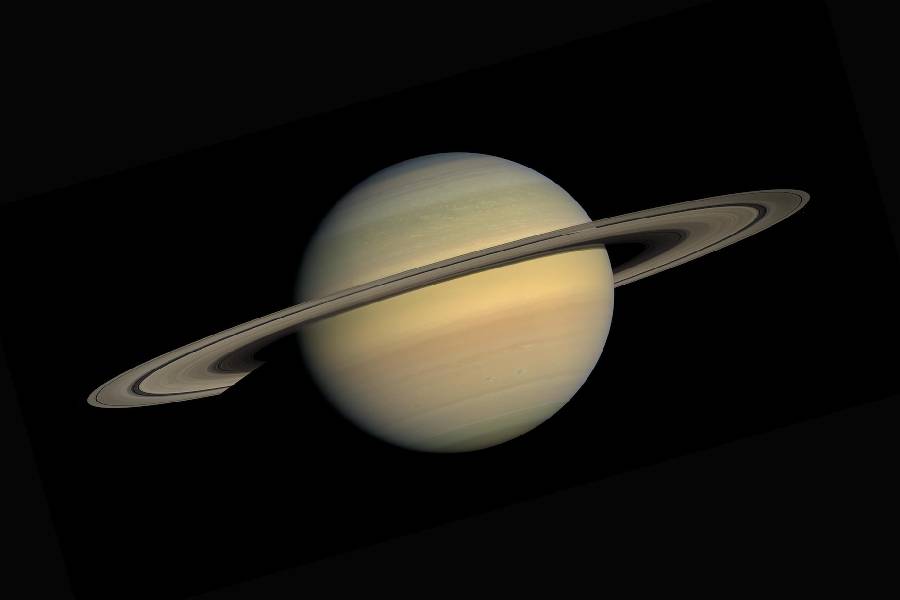With its spectacular rings and golden color, Saturn captures the imagination like few other celestial bodies. But is Saturn a planet based on the current criteria?
Like Jupiter, Saturn is classified as a gas giant and composed mainly of hydrogen and helium. It has over 150 moons, including the intriguing Titan, and an expansive ring system containing ice and rock particles. Based on what we can observe, Saturn seems like a planet.
But looking deeper, there are reasons why Saturn’s status as a planet has been questioned. Does it fit the definition of a planet that has been established by astronomers? Are there aspects of Saturn that set it apart from the other worlds in our solar system?
To determine if Saturn qualifies as a bonafide planet or something else entirely, we need to examine the characteristics that define what makes a planet and see how Saturn measures up. Does it orbit a star? Is it rounded by gravity? Has it cleared its orbit? The answer may not be as straightforward as it seems.
Is Saturn a Planet?
Is Saturn a planet? Saturn is indeed a planet, and it’s the sixth world from the Sun and the second largest planet in our solar system. It is characterized by its stunning ring system, making it a prominent member of our solar system.

Saturn’s Characteristics
Physical characteristics of Saturn
Saturn has a number of physical characteristics that make it unique in our solar system. It is the sixth planet from the Sun and the second largest planet after Jupiter.
Saturn has a radius of about 36,184 miles (58,232 kilometers), which makes it over nine times wider than Earth. Despite its huge size, Saturn is the least dense planet in the solar system. It is made mostly of hydrogen and helium, giving it a density lower than water.
Saturn orbits the Sun at an average distance of 886 million miles (1.4 billion kilometers), taking just over 29 Earth years to complete one orbit.
Saturn’s rings
The most spectacular and defining feature of Saturn is, without a doubt, its extensive ring system.
The rings extend up to 175,000 miles (282,000 kilometers) from the planet – nearly three-quarters of the distance between Saturn and Earth! They span a width of about 155,000 miles (250,000 kilometers) but are remarkably thin, measuring from 10 to 1000 meters thick.
The rings are composed primarily of billions of ice particles mixed with rocky debris and dust. Though all gas giants have rings, Saturn’s are exceptional in their massive size, complexity, and brightness. The tiny particles in the main rings range in size from a centimeter to several meters.
Saturn’s rings are categorized into seven groups and three major divisions. The brightest is the B Ring, while the A Ring has the widest gap within it. The Cassini Division separating these two main rings is about 2,920 miles (4,700 kilometers) wide. Some fainter, narrower rings and gaps have been found embedded in the main rings.
Shepherd moons like Prometheus and Pandora orbit just inside or outside the rings and help keep the particles gravitationally confined in their narrow bands. The rings also have their own oscillations, resonances, and density waves due to gravitational interactions with moons and Saturn itself.
Saturn’s rings are thought to be remnants of a moon or comet that strayed too close and was torn apart by tidal forces. The debris continues to be shaped by bombardment, gravitational forces, and cleaning effects.
These iconic rings are a defining part of Saturn’s cosmic beauty and mystique. Their immensity, intricacy, and elegant orbital dance make Saturn arguably the most visually stunning planet in our solar system.
Planetary Classification
The International Astronomical Union (IAU) passed a resolution in 2006 that defined a planet in our solar system as an object that:
- Orbits the Sun
- Has sufficient mass and self-gravity to achieve hydrostatic equilibrium, forming a rounded shape
- Has cleared the neighborhood around its orbit of planetesimals
- Using this definition, the IAU recognizes eight planets in our solar system: Mercury, Venus, Earth, Mars, Jupiter, Saturn, Uranus, and Neptune
However, Saturn’s status as a planet has been debated by some astronomers. One objection is related to the vagueness of clearing the neighborhood criteria. The IAU did not quantitatively define what this means.
When looking at the objects near its orbit, Saturn has not cleared its orbital zone to the same degree that other planets have. Some of Saturn’s moons are still closely interacting with the rings.
There are also Trojan asteroids sharing Saturn’s orbit. So while Saturn is the dominant gravitational body in its orbit, it has not completely cleared nearby debris.
Others argue that the abundance of moons and rings makes Saturn more akin to a mini solar system. However, most experts still consider Saturn to unambiguously match the planetary definition.
The ongoing debates reveal the blurry distinctions between planets, dwarf planets, and moons in our solar system. Saturn occupies an intriguing middle ground while still qualifying as a planet.
History of Observation and Exploration
Pre-telescopic observation
Saturn has been known since prehistoric times, as it is visible to the naked eye. Ancient astronomers identified Saturn as one of the five planets visible without magnification. In Roman mythology, Saturn was the father of Jupiter and associated with agriculture and wealth.
The oldest recorded observations of Saturn come from the Assyrians around 700 BCE. Babylonian astronomers systematically observed and recorded the movements of Saturn. In ancient China, Saturn was part of the Five Elements system of cosmology and astrology.
Ancient Greek astronomers like Ptolemy and Arabic astronomers like Al-Zarqali produced mathematical models to predict Saturn’s motion. They noted that Saturn moved more slowly than Jupiter in the night sky.
Telescopic observation
The first person to observe Saturn with a telescope was Galileo Galilei in 1610. His early observations revealed Saturn’s odd appearance, which he compared to ears on each side of the planet. He was unable to make sense of what he was seeing.
In 1655, Christiaan Huygens solved the mystery using an improved telescope. He realized Saturn had a thin, flat ring that did not touch the planet. Huygens shared his discovery in the publication Systema Saturnium.
Further discoveries about Saturn’s rings and moons followed from astronomers like Giovanni Cassini, William Herschel, and James Clerk Maxwell into the 19th and 20th centuries.
Spacecraft observations revolutionized our understanding of Saturn, starting with Pioneer 11 in 1979 and continuing through the Cassini-Huygens mission.
Saturn’s Role in the Solar System
As the second largest planet, Saturn has a significant gravitational influence on other bodies in the solar system. Its gravity helps shape the orbits of moons, ring particles, comets, and more distant trans-Neptunian objects.
Saturn’s largest moon Titan is kept in orbit through gravitational locking with the planet. Some of Saturn’s moons, like Enceladus, experience tidal forces that likely play a role in their geologic activity. The rings are also confined by complex gravitational resonances with moons like Mimas, Janus, and Epimetheus.
The Cassini-Huygens mission dramatically expanded our understanding of Saturn and its moons. Cassini orbited Saturn from 2004-2017, collecting extensive data on the planet, rings and moons.
The Cassini-Huygens lander successfully touched down on Titan in 2005. It helped discover new moons, observed meteorological phenomena on Titan and Saturn and examined interactions between the rings and moons.
Defending Saturn’s Planetary Status
Saturn unambiguously meets the three critical criteria set forth by the International Astronomical Union (IAU) for an object to be classified as a planet – it orbits the Sun, has adequate mass and self-gravity to be rounded into a spherical shape by hydrostatic equilibrium, and has cleared its orbital neighborhood of other objects.
While there are always ongoing debates regarding planetary definitions, Saturn stands as a prototypical example of a planet that fits firmly within the IAU guidelines.
Meeting IAU criteria
There is irrefutable evidence that Saturn is spherical in shape based on direct observations, measurements of its gravitational field, which reveal oblateness consistent with a hydrostatic equilibrium shape, and internal models showing separation into distinct layers like a planet.
Calculations demonstrate Saturn’s immense dominance as the gravitational force in its orbital vicinity. Saturn’s mass is 95 times greater than the total mass of all other objects in its orbital zone combined. It influences the orbits of ring particles, nearby moons, and more distant minor bodies through gravitational resonances and perturbations.
Some common misconceptions are that Saturn does not meet the criterion of clearing the neighborhood as thoroughly as other planets like Earth and that its ring system makes it unique. However, no planet has cleared its orbital zone 100% – Earth still has 10,000 near-Earth asteroids sharing its orbital path.
Jupiter has a subtle ring system of its own, demonstrating this feature is not restricted to just Saturn. More importantly, Saturn’s gravitational supremacy throughout its orbital sphere of influence, extending millions of kilometers in radius, clearly satisfies the intent of the IAU’s principle of clearing the neighborhood, if not the letter of the definition.
Therefore, while Saturn possesses exceptional qualities like its rings and numerous moons, these do not fundamentally distinguish it from its status as a planet. Saturn stands as a captivating example of a gas-giant planet.

Challenges to Saturn’s Planetary Status
Some astronomers question if Saturn should really be considered a planet. They point out two major reasons.
First, Saturn has not completely cleared out other objects from its orbit around the Sun. There are still asteroids called Trojans that go around the Sun in the same orbit as Saturn. Saturn’s many moons also orbit close by and interact with its rings. This makes it seem like Saturn has not fully cleared its neighborhood.
Second, Saturn’s magnificent rings set it apart from other planets. The rings circle Saturn’s equator and contain bits of ice, rock, and dust.
Some experts think the rings are so prominent that maybe Saturn should be classified differently, like a “dwarf planet” along with its rings. After all, the rings are a major part of what makes Saturn so recognizable and remarkable to us.
However, most astronomers still say these unique traits do not disqualify Saturn from being a planet. The official definition does not actually require that a planet clears its orbit 100%.
Saturn’s gravity still dominates the area around its orbit. And while the rings are attention-grabbing, Saturn, like the other gas giants Jupiter, Neptun, and Uranus, has a faint ring system.
So, in the end, there is no scientific consensus that Saturn should not be categorized as a planet just because of its orbit-sharing moons and eye-catching rings. The majority view is that despite some gray areas, Saturn still qualifies as a full-fledged planet.
Scientific Consensus
The current scientific consensus is that Saturn fully meets the IAU definition of a planet and warrants being categorized as such. It orbits the Sun, has sufficient mass and shape for hydrostatic equilibrium, and is the overwhelmingly dominant gravitational force in its orbital vicinity.
While Saturn’s failures to completely clear neighboring regions of moons, rings, and trojan asteroids constitute an imperfect fit to the IAU guidelines, no other plausible definition places Saturn outside the spectrum of a true planet.
Saturn’s remarkable qualities expand our notions of what planetary systems can look like without invalidating its status as a planet.
Frequently Asked Questions
What is the historical significance of Saturn?
Saturn has been known since ancient times and was one of the five observable planets in various ancient cultures. Ancient Babylonian, Chinese, Greek, and Arabic astronomers systematically observed and recorded Saturn’s movements.
In the 16th and 17th centuries, Galileo Galilei and Christiaan Huygens made breakthrough telescopic observations, discovering Saturn’s rings and moons. Saturn has played an important role in the history of astronomy and the Copernican revolution.
Are there any specific features or characteristics of Saturn that have led to debates about its planetary status?
Yes, the two major features are Saturn’s ring system and its collection of moons. Some argue that the extensive ring system differentiates Saturn too much from a typical planet.
Others argue that Saturn has failed to fully clear its orbital neighborhood of objects like Trojan asteroids and its moons. However, neither of these is deemed prohibitive for Saturn to be considered a planet by the IAU definition.
Is Saturn a gas planet?
Yes, Saturn is classified as a gas giant planet, along with Jupiter, Uranus, and Neptune. It is composed primarily of hydrogen and helium gas.
Saturn does likely have a solid core made of rocky/icy materials, but this core is small compared to the gaseous envelope that makes up most of Saturn’s volume. Saturn is the least dense planet in our solar system due to its gaseous composition.

Conclusion
When examining Saturn’s planetary status – is Saturn a planet, we’ve explored how its exceptional features fuel debates on its status. Saturn meets the IAU’s criteria – it orbits the Sun, has sufficient mass for a spherical shape, and is the dominant gravitational force in its orbital zone.
However, Saturn has not fully cleared neighboring regions of moons, rings, and asteroids. This has led some to argue it falls short of the criteria for clearing its neighborhood.
Yet the scientific consensus remains that Saturn undoubtedly qualifies as a planet. It matches the intended meaning of the IAU definition, despite gray areas. While Saturn’s rings and moons make it remarkable, these do not invalidate its planetary status. If anything, they showcase Saturn as an especially captivating type of planet.
Saturn will continue to astound us and challenge definitions. But its exceptional nature is clear – Saturn stands out as one of the most wondrous, beautiful worlds in our solar system. Its classification status may still be debated, but its magnificence is indisputable.

